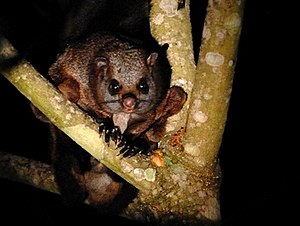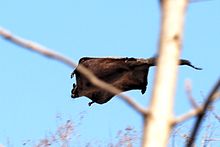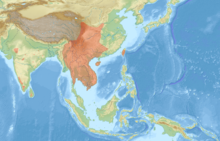Indian giant sliding squirrel
| Indian giant sliding squirrel | ||||||||||||
|---|---|---|---|---|---|---|---|---|---|---|---|---|

Indian giant flying squirrel ( Petaurista philippensis ) |
||||||||||||
| Systematics | ||||||||||||
|
||||||||||||
| Scientific name | ||||||||||||
| Petaurista philippensis | ||||||||||||
| ( Elliot , 1839) |
The Indian giant flying squirrel ( Petaurista philippensis ) is a flying squirrel from the genus of the giant flying squirrel ( Petaurista ). It is distributed from the central and southern People's Republic of China as well as India to Sri Lanka and over large parts of Southeast Asia.
features
The Indian giant gliding squirrel reaches a head-trunk length of 41 to 61 centimeters and a tail length of 55 to 69 centimeters. The rear foot length is 65 to 90 millimeters, the ear length 45 to 47 millimeters. The weight is around 2.2 kilograms. It is one of the largest species of the genus after the red and white giant squirrel ( P. alborufus ) and the Bhutan giant squirrel ( P. nobilis ) and is also one of the largest species of squirrels worldwide.
The back and the skins are colored chestnut brown to black. The hair has white tips that make the fur on the back appear shimmering gray. The ventral side is reddish brown to sandy brown. The black tail without a light tip is comparatively long. The ears are also black on the top and reddish on the front.
Like all giant flying squirrels, it has a large and hairy flight membrane that connects the wrists and ankles and is enlarged by a fold of skin between the hind legs and the base of the tail. The flight membrane is muscular and reinforced at the edge, it can be tensed and relaxed accordingly in order to control the direction of gliding.
The total length of the skull is 65 to 82 millimeters.
distribution
The Indian giant flying squirrel has a very large distribution area, ranging from the central and southern People's Republic of China and India to Sri Lanka and over large parts of Southeast Asia with Myanmar , Laos , Cambodia , Thailand and Vietnam . It also occurs in Taiwan . In China it occurs in several subspecies on the island of Hainan as well as in the provinces of Yunnan , Sichuan and Shaanxi .
Way of life
The Indian giant gliding squirrel lives in subtropical deciduous and coniferous forests and partly in tree plantations, whereby a probable preference for coniferous forests is known at least from Taiwan. In the Western Ghats in India, the animals live mainly on the edges of the forest and in more open forest areas, both in small-scale and in larger forest areas, which means that they are relatively adaptable to logging and habitat changes. On Hainan, on the other hand, the species occurs only in extensive forest areas and in China the species occurs in five of the 12 existing zoogeographical regions.
It lives strictly on trees and feeds almost exclusively on leaves. In Taiwan, leaves of around 30 plant species make up around 74% of the animals' diet. In addition, there are buds and fruits, which are mainly consumed in spring, summer and autumn. In other regions the proportion of leaves can make up between 34 and 61% of the total diet; in the Western Ghats, the animals feed mainly on the fruits of Ficus racemosa , a species of fig , followed by leaves. Here the food is supplemented by flowers, bark and lichens . The Indian giant gliding squirrel is also largely nocturnal, like most species of the genus. Like all other flying squirrels, this species is also able to glide over long distances by jumping off a tree.

The Indian giant flying squirrel builds nests in tree hollows or in the branches of higher trees. Little data is available on reproductive behavior. The species gets its young in spring and autumn, whereby the females usually give birth to one and rarely two young. About half of all females become pregnant in each breeding season.
Larger owls probably play a central role among predators, but little is known about this. The croissants respond to the presence of owls and owl calls with a specific warning call. The western black crested gibbon ( Nomascus concolor ) is also known to prey on flying squirrels.
Systematics
The Indian giant sliding squirrel is classified as an independent species within the genus of the giant sliding squirrel ( Petaurista ), which contains a total of eight to nine species. The first scientific description comes from Daniel Giraud Elliot from 1839 on the basis of individuals from central and northern Nepal. Originally the species also included the Bhutanese giant sliding squirrel ( Petaurista nobilis ), which is now recognized as a separate species.
Depending on the system, a distinction is made within the species between five, seven or up to ten subspecies: The following subspecies are currently considered to be valid:
- Petaurista philippensis philippensis ( nominate form ), is known from India and Nepal
- Petaurista philippensis annamensis , lives in southern Vietnam, Laos and Cambodia
- Petaurista philippensis cineraceus , lives in the Rakhine state in Myanmar
- Petaurista philippensis lylei , lives in northwestern Thailand
- Petaurista philippensis mergulus , lives on the Mergui archipelago belonging to Myanmar
For some forms, an independent species status or an alternative assignment are discussed. The Hainan giant sliding squirrel ( Petaurista hainana ) and the Yunnan giant sliding squirrel ( Petaurista yunanensis ) are now viewed as separate species. The Petaurista philippensis grandis , which was formerly classified in this genus , is now classified as Petaurista petaurista grandis des Taguan and the one described by Thorington et al. Petaurista philippensis nigra and Petaurista philippensis rubicundus, which were regarded as subspecies in 2012, are currently no longer listed as subspecies. According to molecular biological studies, Petaurista grandis is a sister species of the Taguan and Petaurista hainana and Petaurista yunanensis are indeed closely related to the Indian giant flying squirrel , which is to be regarded as a sister species of the red and white giant flying squirrel ( Petaurista alborufus ).
Existence, endangerment and protection
The Indian giant sliding squirrel is classified as not endangered (least concern) by the International Union for Conservation of Nature and Natural Resources (IUCN) due to its large distribution area and its assumed large populations as well as its good adaptability to changed ecosystems.
The species occurs in large parts of the distribution area in comparatively large stocks, in some parts, however, the stocks are in some cases strongly declining. In parts of India the animals are hunted as meat suppliers and are under high hunting pressure. In the Western Ghats and northeast India in particular, populations are likely to be in decline. There are no general hazards or potential threats to the entire population. Despite their adaptability, the stocks can be affected by the loss of forest habitats and the conversion to agricultural and settlement areas. In parts of South Asia and China, hunting for meat as well as for medicinal purposes is a potential threat.
supporting documents
- ↑ a b c d e f g h i Indian Giant Flying Squirrel. In: Andrew T. Smith , Yan Xie: A Guide to the Mammals of China. Princeton University Press, 2008; Pp. 179-180. ISBN 978-0-691-09984-2 .
- ↑ a b c d e f g h i j k Richard W. Thorington Jr., John L. Koprowski, Michael A. Steele: Squirrels of the World. Johns Hopkins University Press, Baltimore MD 2012; Pp. 119-122. ISBN 978-1-4214-0469-1
- ↑ a b c d e Petaurista philippensis in the IUCN Red List of Threatened Species 2010.4. Listed by: J. Walston, JW Duckworth, S. Molur, 2008. Retrieved June 14, 2014.
- ↑ a b c d Don E. Wilson & DeeAnn M. Reeder (Eds.): Petaurista philippensis in Mammal Species of the World. A Taxonomic and Geographic Reference (3rd ed).
- ↑ a b c d J.L. Koprowski, EA Goldstein, KR Bennett, C. Pereira Mendes: Hainan Giant Flying Squirrel Petaurista albiventer. In: Don E. Wilson, TE Lacher, Jr., Russell A. Mittermeier (Eds.): Handbook of the Mammals of the World: Lagomorphs and Rodents 1. (HMW, Volume 6) Lynx Edicions, Barcelona 2016, ISBN 978- 84-941892-3-4 , pp. 775-776.
- ↑ Song Li, Kai He, Fa-Hong Yu, Qi-Sen Yang: Molecular Phylogeny and Biogeography of Petaurista Inferred from the Cytochrome b Gene, with Implications for the Taxonomic Status of P. caniceps, P. marica and P. sybilla. PLOS ONE , July 16, 2013 doi : 10.1371 / journal.pone.0070461
literature
- Richard W. Thorington Jr., John L. Koprowski, Michael A. Steele: Squirrels of the World. Johns Hopkins University Press, Baltimore MD 2012; Pp. 119-122. ISBN 978-1-4214-0469-1
- Indian Giant Flying Squirrel. In: Andrew T. Smith , Yan Xie: A Guide to the Mammals of China. Princeton University Press, 2008; Pp. 179-180. ISBN 978-0-691-09984-2 .
Web links
- Petaurista philippensis inthe IUCN Red List of Threatened Species 2010.4. Listed by: J. Walston, JW Duckworth, S. Molur, 2008. Retrieved June 14, 2014.
